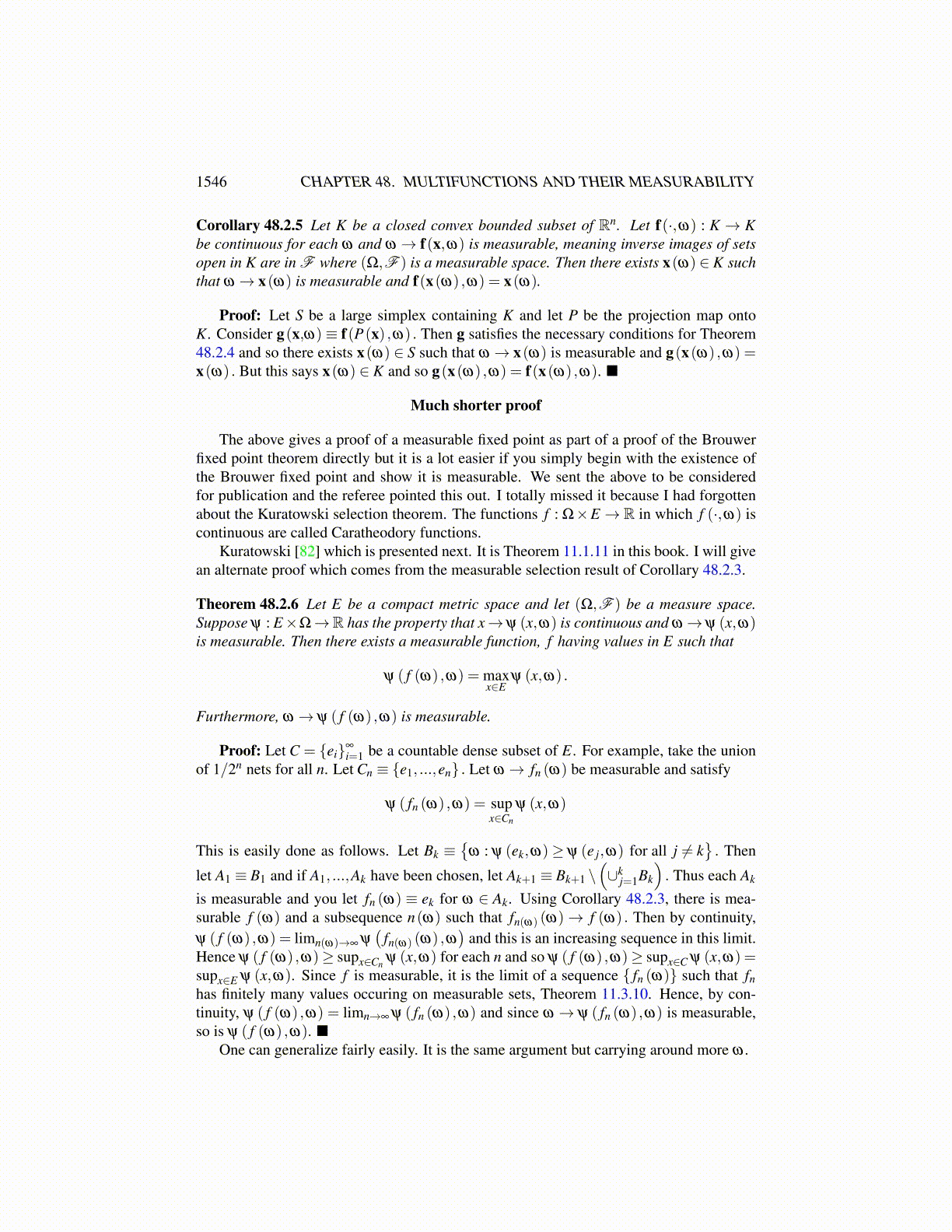
1546 CHAPTER 48. MULTIFUNCTIONS AND THEIR MEASURABILITY
conclusion can be drawn about the si (ω). This is because, thanks to the continuity of f inits first argument, the function on the left in the above is measurable.
Label x j as p j where p0, · · · , pn are the first n+ 1 prime numbers. Thus the verticesof S have been labeled. Next triangulate S so that all simplices have diameter less than ε .If [y0, · · · ,yn] is one of these small vertices, each is of the form ∑
ni=0 tixi where ti ≥ 0 and
∑i ti = 1. Define rk (ω) ≡ sk (ω)/tk if tk > 0 and ∞ if tk = 0. Thus this is a measurablefunction.
Ek ≡ ∩ j ̸=k [ω : rk (ω)≤ r j (ω)] , F0 ≡ E0,F1 ≡ E1 \E0, · · · ,Fn ≡ En \∪n−1i=0 Ei
Then p(yi,ω) will be the label placed on yi. It equals
p(yi,ω)≡n
∑k=0
pkXFk (ω)
obviously a measurable function. Note also that this new method of labeling does notcontradict the original labels placed on the vertices xi. This is because for xi, ti = 1 andall other t j = 0 so the only ratio that is finite will be si/ti. All others are ∞ by definition.As for the vertices which are on the kth face [x0, · · · , x̂k, · · · ,xn] , these will be labeled fromthe list {p0, · · · , p̂k, · · · , pn} because tk = 0 for each of these and so rk (ω) = ∞. By theSperner’s lemma procedure described above, there are an odd number of simplices havingvalue ∏i̸=k pi on the kth face and an odd number of simplices in the triangulation of S forwhich the product of the labels on their vertices equals p0 p1 · · · pn ≡ Pn. We call this thevalue of the simplex. Thus if [y0, · · · ,yn] is one of these simplices, and p(yi,ω) is the labelfor yi, a measurable function of ω,
n
∏i=0
p(yi,ω) =n
∏i=0
pi ≡ Pn
For ω ∈ Fk, what is rk (ω)? Could it be larger than 1? rk (ω) is certainly finite becauseat least some t j ̸= 0 since they sum to 1. Thus, if rk (ω) > 1, you would have sk (ω) > tk.The s j sum to 1 and so some s j (ω)< t j since otherwise, the sum of the t j equalling 1 wouldrequire the sum of the s j to be larger than 1. Hence rk (ω) was not really the smallest soω /∈ Fk. Thus rk (ω)≤ 1. Hence sk (ω)≤ tk.
Let S denote those simplices whose value is Pn for some ω . In other words, if{y0, · · · ,yn} are the vertices of one of these simplices, and
ys =n
∑i=0
tsi xi
then for some ω, rks (ω) ≤ r j (ω) for all j ̸= ks and {k0, · · · ,kn} = {0, · · · ,n}. There arefinitely many of these simplices, so S ≡ {S1, · · · ,Sm}. Let F1 ⊆Ω be defined by
F1 ≡
{ω :
n
∏i=0
p(yi,ω) = Pn
}: [y0, · · · ,yn] = S1